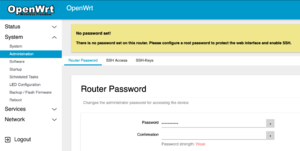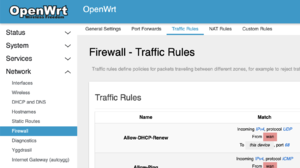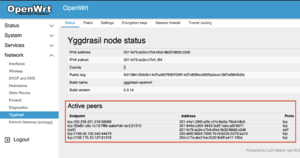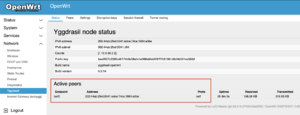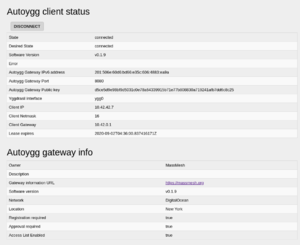Difference between revisions of "First Time Setup"
Stephen304 (talk | contribs) |
m (→Authorize the Maintenance Team to Access Your Mesh Node: Changed my pubkey) |
||
| Line 33: | Line 33: | ||
# Enter the following keys, clicking "Add Key" in between each | # Enter the following keys, clicking "Add Key" in between each | ||
<pre> | <pre> | ||
| − | ssh-rsa | + | ssh-rsa AAAAB3NzaC1yc2EAAAADAQABAAABgQCqb+eTvCL3tilg3xKpLdClC0BuJiDXCiIsgYhoO5/6Rf6u/FGQYUGPwyhCqoXNeGhUhAIHUvD+HIcMfvFgdTRJ/K7uSe35FmrobT3QGpKMLwq2+HJNhIbK18n4SeL74JGfntnecw2Wbfd9qy9UAyM7422BVttGDcgRZzaj+Lzf5hc4gLT8J3zv8ybLOAxFOcwQV+TPg76jMIHr7BnAIxCQZEOsFydNINnJLn5WjezzeDvX2sTJbLe7lsHE8oE7YDyZxFw39F9t8AGg96xgnTJvYv9JG3dczgTicB+dj1C0FnlhZD8o9k6xcMex2mSpR2jmcf8TluFladVuQlP4/oEiz0rOZ7PAYC5BWXx1i4PwWm/Xas3TcGg1WokWSAcijUpeqhkEekQk4RXWfrdKDoGLQF3rAbmdD9gz4MuxuNoyXKmdhvwsBeqzNnADqHllcw95+gNVYUJz1VNM2oPfNvHtOY624YY9rWy/uL6plocM07Vtvf8/CKuQ+fPIcRhwJDk= lurker@join-or-die |
ssh-rsa AAAAB3NzaC1yc2EAAAABIwAAAgEA3nzI6T6Lpd5xFoRewcx91Dv9sUzNNmdYfwOleemBFz0y3RaQElehUWasyjuIURZw7RL5EjvrqeQq9pe/lO99dO0F9yMuMsMH2t88YrVJQ/z/5Aa4I2zYQotKb/9CCfynsy41y5xywxtOwXiDk2kpo+c9VZCyCeW8Hnc9HaIpkKSLnkqDVhESzlrkYyNKZvUAL1hiFIzmmw/veFgRb7/ol76Ze3xsWugbHUECEIAKoz/8uaevOAAoJrMFhffFIQ8IfClqDZv2lnBBhvh1O9TO0Mg4klcieyQ1RZhMjeP4WnAa9PXP7xZlQHLgO9qO1jDd2sOdkX6EedCfX5jO4Y51HPJpV35uYumw3veftMlpIJFmA2eIQxU19SCYpojWRGXZ5v9WtFIHX2nGy+Gi1bk7TR+HBsCDXOPhhQk4ceIM4OonqEb1NJ57elxh6mFbDAQCZtYhRLqYvcyGpuBdVdLNOJbOZ7vBJY3Kfjxa87rvFIJheT6DXhpdRayeOovLm0vuJ53bZoWxWOqjpuigQqHtSB3OmintrKB916BhNFsHwPeZpK0ahZGFygV63REM/X8m0nOlHqyAY69uzLHyYXM83zAI1L5Y4wuzsVqO+1tnK6PMcfg5/DArjBrn7YqA5tzJY9EgdVVPjpgjD2yYYTOP6b3UUw4uFj3asnOX24dfVzk= ward@countzero | ssh-rsa AAAAB3NzaC1yc2EAAAABIwAAAgEA3nzI6T6Lpd5xFoRewcx91Dv9sUzNNmdYfwOleemBFz0y3RaQElehUWasyjuIURZw7RL5EjvrqeQq9pe/lO99dO0F9yMuMsMH2t88YrVJQ/z/5Aa4I2zYQotKb/9CCfynsy41y5xywxtOwXiDk2kpo+c9VZCyCeW8Hnc9HaIpkKSLnkqDVhESzlrkYyNKZvUAL1hiFIzmmw/veFgRb7/ol76Ze3xsWugbHUECEIAKoz/8uaevOAAoJrMFhffFIQ8IfClqDZv2lnBBhvh1O9TO0Mg4klcieyQ1RZhMjeP4WnAa9PXP7xZlQHLgO9qO1jDd2sOdkX6EedCfX5jO4Y51HPJpV35uYumw3veftMlpIJFmA2eIQxU19SCYpojWRGXZ5v9WtFIHX2nGy+Gi1bk7TR+HBsCDXOPhhQk4ceIM4OonqEb1NJ57elxh6mFbDAQCZtYhRLqYvcyGpuBdVdLNOJbOZ7vBJY3Kfjxa87rvFIJheT6DXhpdRayeOovLm0vuJ53bZoWxWOqjpuigQqHtSB3OmintrKB916BhNFsHwPeZpK0ahZGFygV63REM/X8m0nOlHqyAY69uzLHyYXM83zAI1L5Y4wuzsVqO+1tnK6PMcfg5/DArjBrn7YqA5tzJY9EgdVVPjpgjD2yYYTOP6b3UUw4uFj3asnOX24dfVzk= ward@countzero | ||
Revision as of 17:55, 9 January 2021
Contents
Setting Your Password
When you first boot your mesh node, there is no password set. This is quite dangerous, so OpenWrt will disable many useful features until you set one. Therefore, it is important that you set one up right away.
To set a password, complete the following steps:
- Navigate to "System > Administration" in the left-hand menu of OpenWrt
- Enter your desired password twice, and hit Enter or click "Save."
Enabling Remote Support
Following these steps, you will allow a maintainer to log into and use your mesh node remotely -- as long as it's connected to the global Yggdrasil network. See #The Yggdrasil Page if you think you may not be connected to the rest of the Yggdrasil network.
In order to enable remote support, you will need to:
- Authorize the maintenance team to access your mesh node
- Allow SSH over Yggdrasil
Authorize the Maintenance Team to Access Your Mesh Node
- Navigate to System > Administration
- Select the "SSH-Keys" tab
- Enter the following keys, clicking "Add Key" in between each
ssh-rsa AAAAB3NzaC1yc2EAAAADAQABAAABgQCqb+eTvCL3tilg3xKpLdClC0BuJiDXCiIsgYhoO5/6Rf6u/FGQYUGPwyhCqoXNeGhUhAIHUvD+HIcMfvFgdTRJ/K7uSe35FmrobT3QGpKMLwq2+HJNhIbK18n4SeL74JGfntnecw2Wbfd9qy9UAyM7422BVttGDcgRZzaj+Lzf5hc4gLT8J3zv8ybLOAxFOcwQV+TPg76jMIHr7BnAIxCQZEOsFydNINnJLn5WjezzeDvX2sTJbLe7lsHE8oE7YDyZxFw39F9t8AGg96xgnTJvYv9JG3dczgTicB+dj1C0FnlhZD8o9k6xcMex2mSpR2jmcf8TluFladVuQlP4/oEiz0rOZ7PAYC5BWXx1i4PwWm/Xas3TcGg1WokWSAcijUpeqhkEekQk4RXWfrdKDoGLQF3rAbmdD9gz4MuxuNoyXKmdhvwsBeqzNnADqHllcw95+gNVYUJz1VNM2oPfNvHtOY624YY9rWy/uL6plocM07Vtvf8/CKuQ+fPIcRhwJDk= lurker@join-or-die ssh-rsa AAAAB3NzaC1yc2EAAAABIwAAAgEA3nzI6T6Lpd5xFoRewcx91Dv9sUzNNmdYfwOleemBFz0y3RaQElehUWasyjuIURZw7RL5EjvrqeQq9pe/lO99dO0F9yMuMsMH2t88YrVJQ/z/5Aa4I2zYQotKb/9CCfynsy41y5xywxtOwXiDk2kpo+c9VZCyCeW8Hnc9HaIpkKSLnkqDVhESzlrkYyNKZvUAL1hiFIzmmw/veFgRb7/ol76Ze3xsWugbHUECEIAKoz/8uaevOAAoJrMFhffFIQ8IfClqDZv2lnBBhvh1O9TO0Mg4klcieyQ1RZhMjeP4WnAa9PXP7xZlQHLgO9qO1jDd2sOdkX6EedCfX5jO4Y51HPJpV35uYumw3veftMlpIJFmA2eIQxU19SCYpojWRGXZ5v9WtFIHX2nGy+Gi1bk7TR+HBsCDXOPhhQk4ceIM4OonqEb1NJ57elxh6mFbDAQCZtYhRLqYvcyGpuBdVdLNOJbOZ7vBJY3Kfjxa87rvFIJheT6DXhpdRayeOovLm0vuJ53bZoWxWOqjpuigQqHtSB3OmintrKB916BhNFsHwPeZpK0ahZGFygV63REM/X8m0nOlHqyAY69uzLHyYXM83zAI1L5Y4wuzsVqO+1tnK6PMcfg5/DArjBrn7YqA5tzJY9EgdVVPjpgjD2yYYTOP6b3UUw4uFj3asnOX24dfVzk= ward@countzero ssh-rsa AAAAB3NzaC1yc2EAAAADAQABAAACAQDVi8ExDYdV7EfkjQiMZA3o0QtjVNtd0wVzp9n1xFqY1dse/zHBqrEZQKBtbrk7D/NAI4qzoogC6SbHWa8fHPyc3LJuKbxHrSC8xylByGL7nAzI7AfmsHCQ8Z+OrgI625PzVpMCY/30D/rBgR2JTlzxlA35cuOPjN5r1HHE53+mVRu62jn/wTa16ubFXaYmibpZ3C830+qsAB8RPEHJH7zknFNPponAqH7kt1I8WQL6fa2TCuxIBijzDLbtX1xH4klTeMRJTK+tmLRUUjUefD/f7lNlgce7o9zkHktO5u1hmpC95/NC2cylzU9RWglHqJ21fSg66y441lm0Y9ZUc2p7DQFQP0f6kovuPWgVPWuMCQHVPgCWqqlKfTK3Dyscn9MfsCUnN2fZY+T0fx3lutLcIOwvQc/N2EDJIb0/R+7XMrzfUDVrkGeBoG11tBkKjltdC19JrAmGAkfIcN0LMOeZT7yTlZ/f/6d5C19DegXX74owM4V4pkqs/hbpmDkvQYkSXPfVpZ9ZTVUVSBrwKVaVX9A1hTXjIzfsuoZheMIdlakt0qSIuukyaIxzi1aAH67nR0kp+XCLldBDXGKQXah+mIGQPDBwWFR34re40jzxKmvLT+Dq+5yASgoLDbul8IYDJa2r7yYZQu+EgsW24p62q+y041wW4YIGBJs/cQqpCw== stephen304@gmail.com
Allow SSH over Yggdrasil
- Navigate to Network > Firewall
- Select the "Traffic Rules tab
- Scroll down to "Allow-SSH-Yggdrasil"
- Enable the Accept input checkbox
- Click "Save and Apply"
The Diagnostic Page
The Yggdrasil Page
One of the most helpful screens for troubleshooting is the Yggdrasil page. This page is entirely focused on your mesh node's status within the global Yggdrasil mesh network. You can access the Yggdrasil page by selecting "Network > Yggdrasil" on the right-hand menu in OpenWrt.
Important Yggdrasil Information
You can view important information about your mesh node in the Yggdrasil screen. Among other things, you can view your node's static IPv6 address and public key.
Your static IPv6 address is unique to the Yggdrasil, and never changes. It comes in handy very frequently, and is used for remote support (among other things.) Your public key is sometimes used to gain access to private resources on the Yggdrasil network. It's good to know where it is just in case you ever need it.
Checking for Peers
As long as your mesh node has public Yggdrasil peers, it is connected to the global Yggdrasil mesh network. This means that things like remote support will work properly. If you're interested in learning more about Yggdrasil vs. the Internet vs. the LAN, see our Network Architecture page.
A working mesh node should have several peers. You can see these in the following screen:
If you don't have any peers, your Yggdrasil screen will look something like this:
The Internet Gateway Page
Once you are connected to the Yggdrasil mesh network (see previous section), it is time to configure the node for internet access. To do so, the node needs to be connected to an internet gateway. We use a program called Autoygg for this purpose. You can access the Internet Gateway page by selecting "Network > Internet Gateway" in the left-hand menu in OpenWrt.
The Autoygg client status page
The Status page shows the current connection state with the configured Autoygg Gateway. On first boot, the page will show that you are disconnected:
The Autoygg client settings page
On the Settings page, an Internet Gateway server can be configured. It is also possible (but not required) to populate your name, e-mail address and/or phone number, to identify yourself to the gateway owner.
Connecting to a Mass Mesh public Internet Gateway
Mass Mesh runs a public Internet Gateway at the address 201:506e:60d6:bd66:e35c:606:4883:ea9a. If you would like to use it to connect to the internet, put that address in the autoygg gateway field and click SAVE & APPLY:
At this point, the Status page will show you are not connected:
Before you can connect to the internet via the Mass Mesh gateway, one of our volunteers will need to add your node to the accesslist on the gateway server. You can request this in the Mass Mesh AP Hosts chat room. Please provide your Yggdrasil IPv6 address when you do so, which is available on the Yggdrasil node status page:
Once your node is added to our accesslist, you can hit the Connect button and if that goes well, the status page will look similar to this:
Connecting to your own Internet Gateway
It is also possible to run your own Internet Gateway server. This can be done on a cheap cloud VPS, for instance. It requires installing and running the Autoygg server. If you want assistance with this, please ask in the MassMesh Tech chat room.

